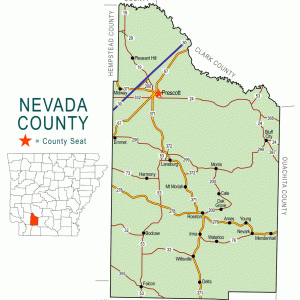calsfoundation@cals.org
Laneburg (Nevada County)
Laneburg is an unincorporated community in Nevada County about eight miles southeast of Prescott (Nevada County) and about fourteen miles east of Hope (Hempstead County). The community is located at the intersection of U.S. Highway 371 and Arkansas Highway 372.
Early settlers in the area included John Norris, who obtained a federal land patent for forty acres of land in the area in 1839. Gad Bradly, a free African-American man, moved onto 120 acres southwest of Laneburg in 1839 and received the patent to the land in 1844. Melson Washington also obtained forty acres in the community in 1849. Other early landowners included George Smith and Calvin McCleland, who jointly obtained 160 acres in 1851.
Before the formation of Nevada County in 1871, the area around Laneburg belonged to Hempstead County. Many people moved to the area in the late nineteenth century, and it became a thriving agricultural settlement. The first county seat, Mount Moriah, is located about three miles southeast of the community.
A branch of the Agricultural Wheel represented farmers in Laneburg, joining with wheel groups from other nearby settlements, including Prescott in 1888, to select local businesses to patronize. Later that same year, the Laneburg chapter established a co-op store in the community.
Efforts to open a boarding school in the area began in 1886. Advertisements in local newspapers for the Harmony Male and Female Institute placed the new school near Laneburg. For unknown reasons, the school did not open. Other mentions of a school in the area appear in 1887, 1888, and 1889. Students residing in the community in the 1880s attended high school in Prescott. By 1890, a public school was in regular operation in the community, with the term beginning in July.
The Laneburg Central School served as the public school in the area from the early 1900s. Located on Highway 372, the school included elementary and high school grades. The local school board took bids for the construction of a new building in 1915. The schools operated as part of the Laneburg District until 1985, when it joined with four other districts to create the Nevada County School District.
Sources differ on the origin of the name of the community. One source suggests that the community was named in honor of resident B. T. Lane, who operated a store. He also bought cotton from nearby farmers. Another reports that the community was named for resident Anna Lane.
Early businesses in the community included a wood-working and blacksmith shop operated by James Lee and John Harris, which opened in 1889. The lack of railroad access hampered the development of the community. The nearest rail junction was located in Prescott, and business relations between the two communities were close, with many mentions of stores and other Laneburg-related information regularly appearing in the Prescott newspapers.
The Laneburg Missionary Baptist Church opened in 1890. The Laneburg Post Office opened in 1894 and closed on May 10, 2008. Service was assumed by the Prescott Post Office. Numerous stores operated in the community over the decades, with the last one located at the intersection of the two highways. It closed at an unknown date in the early twenty-first century. Berkman Lumber Company operated a mill in the community in the early twentieth century until it was sold to the Ozan Lumber Company in 1910.
An article in the Nevada News in 1906 described the town, which included Methodist, Presbyterian, and Baptist churches. Two stores served the community, as well as a doctor who also served as a pharmacist. The post office served the Rosston (Nevada County) community with a rural route. The community was connected to Prescott by an improved road with an iron bridge over Carouse Creek. A telephone line also connected the two communities.
The community was struck by a tornado on November 25, 1915. The town received some damage, including at least one house and numerous barns and other outbuildings destroyed and one person injured.
Numerous cemeteries are located in the community. The Laneburg Cemetery includes marked graves dating to 1895 and continues to be used in the twenty-first century. The cemetery is located next to the Laneburg Baptist Church. The Laneburg Cemetery West serves the African-American community, and the earliest marked graves date to 1932. To the southwest of Laneburg, Pisgah Cemetery includes marked graves that date to 1882. South of Laneburg, the New Salem Cemetery is located behind the New Salem Church with the oldest marked grave dating to 1889.
In the twenty-first century, the community includes several homes and churches. The churches include New Salem Methodist Church, Laneburg Baptist Church, and Laneburg United Pentecostal Church. The area continues to be used for various agricultural purposes including poultry farms, cattle, and timber.
For additional information:
“Cyclone Strikes Laneburg Vicinity.” Prescott Daily News, November 26, 1915, p. 1.
“Interesting Laneburg.” Nevada News, September 1, 1906, p. 1.
Nevada County Depot and Museum. http://www.depotmuseum.org (accessed April 14, 2021).
David Sesser
Henderson State University
 Nevada County Map
Nevada County Map 




Comments
No comments on this entry yet.